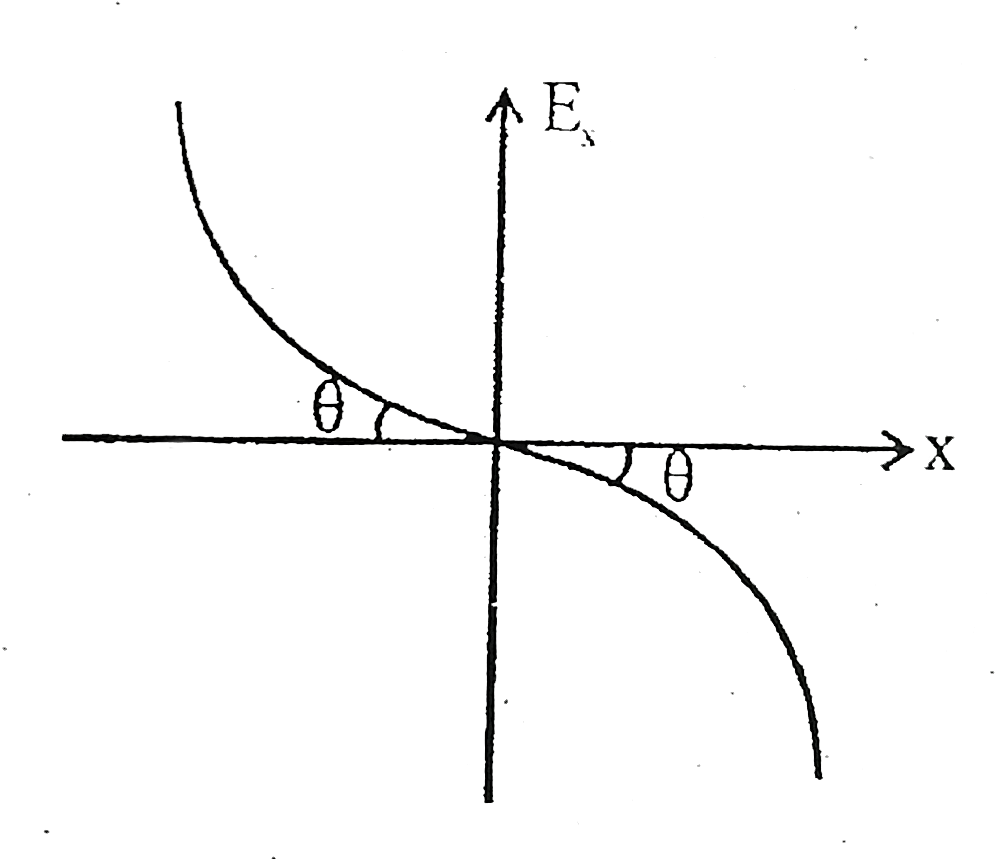The electric potential in a region is given by the relation V(x)=4+5x2. If a dipole is placed at position (-1,0) with dipole moment →P pointing along positive y-direction, then
net force on the dipole is zero.
net torque on the dipole is zero.
net torque on the dipole is not zero and it is in clockwise direction.
Net torque on the dipole is not zero and it is in anticlockwise direction.
The correct Answer is:A, C
To solve the problem, we will follow these steps:
Step 1: Find the Electric Field
The electric potential V(x) is given by:
V(x)=4+5x2
The electric field E is related to the electric potential by the equation:
E=−dVdx
Calculating the derivative:
dVdx=ddx(4+5x2)=10x
Thus, the electric field is:
E=−10x
Step 2: Evaluate the Electric Field at the Dipole's Position
The dipole is placed at position (−1,0):
E(−1)=−10(−1)=10N/C
The electric field at the position of the dipole is 10N/C in the positive x-direction.
Step 3: Determine the Torque on the Dipole
The torque τ on a dipole in an electric field is given by:
τ=→P×→E
Given that the dipole moment →P is directed along the positive y-direction and →E is directed along the positive x-direction, the angle θ between →P and →E is 90∘.
The magnitude of the torque is:
|τ|=P⋅E⋅sin(90∘)=P⋅E
Since sin(90∘)=1, the torque is maximized.
Step 4: Determine the Potential Energy of the Dipole
The potential energy U of a dipole in an electric field is given by:
U=−→P⋅→E
Since →P and →E are perpendicular, the potential energy becomes:
U=−P⋅E⋅cos(90∘)=0
Step 5: Analyze the Options
- Option A: The net force on the dipole is zero. This is true because the forces on the positive and negative charges of the dipole are equal and opposite.
- Option B: The net torque on the dipole is zero. This is false because there is a non-zero torque acting on the dipole.
- Option C: The net torque on the dipole is not zero and is in the clockwise direction. This is true, as the torque is maximized and acts to rotate the dipole.
- Option D: The net torque acting is in the counterclockwise direction. This is false.
Conclusion
The correct options are A and C.
---
The electric potential V(x) is given by:
V(x)=4+5x2
E=−dVdx
dVdx=ddx(4+5x2)=10x
E=−10x
The dipole is placed at position (−1,0):
E(−1)=−10(−1)=10N/C
The electric field at the position of the dipole is 10N/C in the positive x-direction.
The torque τ on a dipole in an electric field is given by:
τ=→P×→E
|τ|=P⋅E⋅sin(90∘)=P⋅E
The potential energy U of a dipole in an electric field is given by:
U=−→P⋅→E
U=−P⋅E⋅cos(90∘)=0
- Option A: The net force on the dipole is zero. This is true because the forces on the positive and negative charges of the dipole are equal and opposite.
- Option B: The net torque on the dipole is zero. This is false because there is a non-zero torque acting on the dipole.
- Option C: The net torque on the dipole is not zero and is in the clockwise direction. This is true, as the torque is maximized and acts to rotate the dipole.
- Option D: The net torque acting is in the counterclockwise direction. This is false.
The correct options are A and C.
Similar Questions
The electric potential at any point x,yandz in metres is given by V=3x2. The electric field at a point (2,0,1) is
View SolutionAn electric dipole is placed at origin in the xy plane with its orientation along the positive x-axis. The direction is electric field .
View SolutionAn electric dipole is placed along x-axis with its centre at origin:
View SolutionA small electric dipole is placed at origin with its dipole moment directed along positive x-axis .The direction of electric field at point (2,2√2,0)
View SolutionIf the electric potential in a region is represented as V=2x+3y−4z.Then electric field vector will written as
View SolutionAn electric dipole has the magnitude of its charge as q and its dipole moment is p. It is placed in a uniform electric field E. If its dipole moment is along the direction of the field, the force on it and its potential energy are respectively
View SolutionAn electric dipole has the magnitude of its charge as q and its dipole moment is p. It is placed in a uniform electric field E. If its dipole moment is along the direction of the field, the force on it and its potential energy are respectively
(a) 2qE and minimum (b) qE and pE
(c) zero and minimum (d) qE and maximumView SolutionThe electric potential V at any point (x,y,z), all in meters in space is given by V=4x2 volt. The electric field at the point (1,0,2) in volt//meter is
View SolutionVariation of x-component of electric field with x-coordinate in a region is given in the graph. A small electric dipole having dipole moment p0ˆi is placed at origin, then net force on the dipole is:
 View Solution
View SolutionThe electric potential at a distance of 3 m on the axis of a short dipole of dipole moment 4×10−12 coulomb-metre is
View Solution

